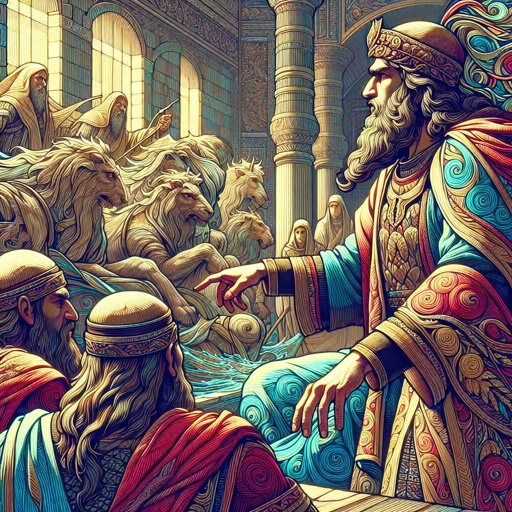What does Numbers 5:1 mean?
"And the LORD spake unto Moses, saying," - Numbers 5:1

Numbers 5:1 - "And the LORD spake unto Moses, saying,"
Numbers 5:1 in the King James Version of the Bible states, “And the Lord spake unto Moses, saying.” At first glance, this verse may seem simple and straightforward, but upon closer examination, it holds profound meaning and significance within the context of the Israelites’ journey and the overarching themes of the book of Numbers. In order to fully understand the depth of this verse, it is important to consider the historical and cultural context, as well as the themes and symbolism present in this passage.
The book of Numbers is the fourth book of the Bible and is a foundational text in the Hebrew Bible, chronicling the journey of the Israelites from Mount Sinai to the border of the Promised Land. The book takes its name from the two censuses that are recorded within its chapters, which reveal the organization and structure of the Israelite community during their time in the wilderness. Additionally, the book of Numbers highlights the numerous challenges and struggles the Israelites faced as they journeyed through the desert, and the ways in which they sought to remain faithful to God amidst these trials.
In Numbers 5:1, we find the Lord speaking directly to Moses. This direct communication from God to His chosen leader, Moses, is significant in several ways. Firstly, it underscores the importance of divine guidance and communication in the Israelites’ journey. Throughout the book of Numbers, we see the Israelites relying on God for direction, protection, and provision as they navigate the challenges of the wilderness. The fact that God speaks directly to Moses highlights the special relationship and communication that exists between God and His chosen people, as well as the pivotal role that Moses plays in relaying God’s messages to the Israelites.
Furthermore, the act of God speaking to Moses demonstrates the overarching theme of divine leadership and authority present in the book of Numbers. The Israelites looked to Moses as their chosen leader, and his close communication with God served as a source of guidance and assurance for the entire community. This theme of divine leadership and authority is woven throughout the narrative of Numbers, as Moses is called upon to enact God’s will and lead the Israelites according to God’s commands.
Additionally, the passage in Numbers 5:1 serves as a reminder of the Israelites’ covenant relationship with God. The Lord speaking to Moses signifies the ongoing presence and engagement of God in the lives of His people, and His commitment to guiding and directing them as they journey towards the Promised Land. This theme of covenant and faithfulness is central to the book of Numbers, as it underscores the reciprocal relationship between God and His people, wherein God promises to be their God and they, in turn, commit to following His commands and remaining faithful to Him.
Symbolically, the act of God speaking to Moses in Numbers 5:1 can be seen as a representation of the ongoing communication and relationship between God and His people. It serves as a reminder of the importance of seeking God’s guidance and direction in our own lives, and the assurance that God is present and actively involved in the lives of those who seek Him.
In conclusion, Numbers 5:1 holds deep significance within the context of the Israelites’ journey and the overarching themes of divine leadership, covenant, and faithfulness present in the book of Numbers. This verse serves as a reminder of the ongoing communication and relationship between God and His people, as well as the importance of seeking divine guidance and direction in our lives. As we consider the message of Numbers 5:1, we are encouraged to reflect on our own relationship with God and the ways in which we can seek His guidance and remain faithful to Him in our own journeys.
Numbers 5:1 Artwork

Numbers 5:1 - "And the LORD spake unto Moses, saying,"

Numbers 1:5 - "¶ And these are the names of the men that shall stand with you: of the tribe of Reuben; Elizur the son of Shedeur."

Numbers 5:5 - "¶ And the LORD spake unto Moses, saying,"

Numbers 5:11 - "¶ And the LORD spake unto Moses, saying,"

Numbers 27:5 - "And Moses brought their cause before the LORD."

Numbers 3:5 - "¶ And the LORD spake unto Moses, saying,"

Numbers 13:5 - "Of the tribe of Simeon, Shaphat the son of Hori."

Numbers 8:5 - "¶ And the LORD spake unto Moses, saying,"

Numbers 33:5 - "And the children of Israel removed from Rameses, and pitched in Succoth."

Numbers 29:5 - "And one kid of the goats for a sin offering, to make an atonement for you:"

Numbers 5:16 - "And the priest shall bring her near, and set her before the LORD:"

Numbers 5:28 - "And if the woman be not defiled, but be clean; then she shall be free, and shall conceive seed."

Numbers 14:5 - "Then Moses and Aaron fell on their faces before all the assembly of the congregation of the children of Israel."

Numbers 5:31 - "Then shall the man be guiltless from iniquity, and this woman shall bear her iniquity."

Numbers 24:5 - "How goodly are thy tents, O Jacob, and thy tabernacles, O Israel!"

Numbers 1:7 - "Of Judah; Nahshon the son of Amminadab."

Numbers 1:15 - "Of Naphtali; Ahira the son of Enan."

Numbers 10:5 - "When ye blow an alarm, then the camps that lie on the east parts shall go forward."

Numbers 5:29 - "This is the law of jealousies, when a wife goeth aside to another instead of her husband, and is defiled;"

Numbers 1:14 - "Of Gad; Eliasaph the son of Deuel."

Numbers 1:11 - "Of Benjamin; Abidan the son of Gideoni."

Numbers 1:9 - "Of Zebulun; Eliab the son of Helon."

Numbers 1:13 - "Of Asher; Pagiel the son of Ocran."

Numbers 1:6 - "Of Simeon; Shelumiel the son of Zurishaddai."

Numbers 1:12 - "Of Dan; Ahiezer the son of Ammishaddai."

Numbers 1:8 - "Of Issachar; Nethaneel the son of Zuar."

Numbers 31:1 - "And the LORD spake unto Moses, saying,"

Numbers 34:1 - "And the LORD spake unto Moses, saying,"

Numbers 28:1 - "And the LORD spake unto Moses, saying,"

Numbers 5:23 - "And the priest shall write these curses in a book, and he shall blot them out with the bitter water:"